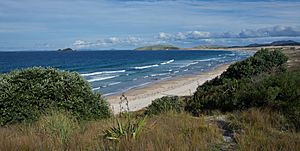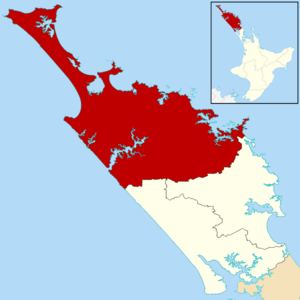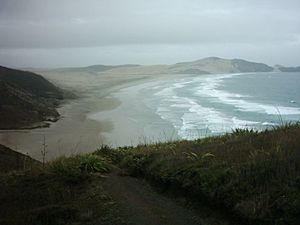Far North District facts for kids
Quick facts for kids
Far North District
Te Hiku o te Ika
|
|
|---|---|
|
Territorial authority district
|
|
 |
|
 |
|
| Country | New Zealand |
| Region | Northland Region |
| Seat | Kaikohe |
| Area | |
| • Total | 7,323.86 km2 (2,827.76 sq mi) |
| • Land | 6,686.67 km2 (2,581.74 sq mi) |
| Population
(June 2023)
|
|
| • Total | 74,700 |
| • Density | 10.200/km2 (26.417/sq mi) |
| Time zone | UTC+12 (NZST) |
| • Summer (DST) | UTC+13 (NZDT) |
| Postcode(s) |
Map of postcodes
|
| Area code(s) | 09 |
| Website | FNDC.govt.nz |
The Far North District is the northernmost part of New Zealand. It is a special area called a territorial authority district. This means it has its own local government.
The district covers the northern tip of the Northland Peninsula in the North Island. It stretches from North Cape / Otou and Cape Reinga / Te Rerenga Wairua in the very north. It goes all the way down to the famous Bay of Islands, the Hokianga area, and the town of Kaikohe.
The local government for this area is the Far North District Council. Their main office is in Kaikohe. The council has ten members called ward councillors. These councillors represent four different areas or "wards": Te Hiku, Kaikohe-Hokianga, Bay of Islands-Whangaroa, and the Ngā Tai o Tokerau Māori ward. The leader of the council is the mayor of Far North, Moko Tepania, who became mayor in 2022.
Contents
Exploring the Far North District's Geography
The Far North District is the biggest of the three local government areas in the Northland Region. It covers a large area of land.
It starts at the very top of the Aupōuri Peninsula. This includes beautiful capes and bays. It also has Te Oneroa-a-Tōhe / Ninety Mile Beach. The district then extends into the main part of the Northland Peninsula. Here you'll find important harbours like Parengarenga Harbour, Whangaroa Harbour, and the famous Bay of Islands on the east coast. On the west coast, there's the Hokianga harbour.
The Far North District shares its borders with two other districts. These are the Kaipara and Whangarei Districts. They are the other two local government areas in the Northland Region.
People and Communities in the Far North
The Far North District covers about 6,686.67 km2 (2,581.74 sq mi) of land. In June 2023, it had an estimated population of 74,700 people. This means there were about 11.2 people living in each square kilometre.
| Ethnicity | Population |
|---|---|
| New Zealand European |
46,131
|
| Māori |
35,679
|
| Pasifika |
3,834
|
| Asian |
2,265
|
| MELAA |
441
|
| Other |
732
|
| Historical population | ||
|---|---|---|
| Year | Pop. | ±% p.a. |
| 2006 | 55,845 | — |
| 2013 | 55,734 | −0.03% |
| 2018 | 65,250 | +3.20% |
| 2023 | 71,430 | +1.83% |
The population of the district was 71,430 people in the 2023 New Zealand census. This was a good increase of 6,180 people (9.5%) since the 2018 census. It also shows a big jump of 15,696 people (28.2%) since the 2013 census.
The average age of people in the Far North District was 44.3 years old. This is a bit older than the national average of 38.1 years. About 19.9% of the people were under 15 years old. Also, 22.0% were 65 years or older.
People in the Far North District come from many different backgrounds. In the 2023 census, the main ethnic groups were:
- 64.6% European/Pākehā
- 49.9% Māori
- 5.4% Pasifika
- 3.2% Asian
- 0.6% Middle Eastern, Latin American and African New Zealanders
- 1.0% other
It's important to know that people can identify with more than one ethnic group.
Towns and Settlements in the Far North
The Far North District has eight towns where more than 1,000 people live. These towns are home to about 37.0% of all the people in the district.
Here are the main towns and their populations:
| Urban area | Population
(June 2023) |
% of district |
|---|---|---|
| Kerikeri | 8,270 | 11.1% |
| Kaitaia | 6,390 | 8.6% |
| Kaikohe | 4,980 | 6.7% |
| Moerewa | 2,090 | 2.8% |
| Paihia | 1,720 | 2.3% |
| Kawakawa | 1,670 | 2.2% |
| Opua | 1,290 | 1.7% |
| Haruru | 1,210 | 1.6% |
Kaitaia is the northernmost town in the district. Several towns like Kerikeri, Moerewa, Kawakawa, Paihia, Opua, and Russell are found on the east coast. They are all located around the beautiful Bay of Islands. Kaikohe is a central town, located to the west of these coastal towns.
On the west coast, around the Hokianga Harbour, there are other smaller communities. These include Ōmāpere, Opononi, Rawene, Panguru, Kohukohu, and Horeke.
See also
 In Spanish: Far North (Nueva Zelanda) para niños
In Spanish: Far North (Nueva Zelanda) para niños


